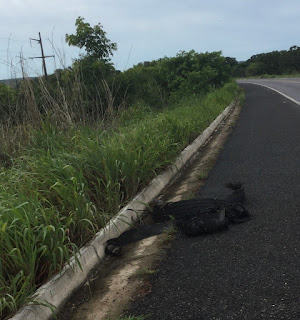After six hundred miles on lightly traveled roads from Brasilia to beyond Palmas I returned to Highway 153, the main south/north trucker route through the interior of Brasil that I followed for some 1,500 miles to Brasilia. It’s only two lanes wide, but I have its wide shoulder all to myself.
There is a lot of traffic, but it’s easy to tune out and retreat to my inner world of bliss of gliding along on my bike in a faraway place closing in on the Amazon. The lush green scenery is increasingly less cultivated or given to cattle. It’s not quite jungle yet, but it is thickening, showing hints of being impenetrable. There is no evidence of slash and burning or much taming or cutting back of the vegetation. It’s mostly wild and undeveloped, still serving as lungs for the planet.
Back on this main thoroughfare it’s ever so sweet to know I’m never more than twenty miles from filling my bottles with ice cold water at a service station and soaking my shirt with water. The biggest bane is avoiding tire carcasses and splintered fragments on the shoulder that are minefields of tiny wires that have caused me a handful of flats. I’ve taken to wiping my front tire every time I pass such a site.
I have an occasional animal carcass to dodge too, mostly snakes and lizards, but not too many as the vultures make quick work of them. I came upon a hoard feasting on a cow that would keep them busy for awhile.
I was very happy I resisted the temptation of the Hotel Economica and it’s rate of 29.90 reals ($7.50) that I had been seeing signs for leading into Miranorte. I took a three-hour lunch at a service station cafeteria in Miranorte avoiding the blistering mid-day heat. The Hotel Economica was right across the street with the air conditioners sticking out of each room, a further temptation along with its rate, the cheapest I’ve seen other than the one-hour rates some motels charge of ten reals. My legs would have welcomed an abbreviated day, but I wasn’t quite ready for a hotel, having had one two nights before on Christmas.
Though it was still steamy when I resumed riding at 3:30, I could see clouds moving in that would blunt the sun’s intensity, which was beginning to wane anyway as it began its long descent to the horizon. Maybe if I hadn’t finished the ebook I was reading over lunch, I might have been inclined to retreat to the cool of the hotel. I had others lined up, thanks to the Chicago Public Library, but none were coming due as was the one I finished—“Gilead,” the Pulitzer Prize winner that so enamored President Obama that he interviewed its author, Marilyn Robinson, for the “New York Review of Books.”
I gave the book a hearty bravo when the 77-year old narrator, a reverend with a heart condition, expressed the wish to his seven-year old son, who the long, chapterless narrative was addressed to, that when he gained his age that he would have seen more of the world than he had. Not venturing often or far from his small-town in Iowa was one of the few regrets in his life. He said he only had himself to blame.
Not seeing enough of the world is not a regret I have to worry about, though the more I see, the more I want to see. I didn’t see enough of Uruguay at the start of this trip and there is a lot more to see in Brasil than I will have seen on this trip. I would have liked to have seen the town of Americana that was established by Southerners after the Civil War where they could continue their cotton growing ways with slave labor, but it was a hundred mile detour off my route.
It would be an even greater detour and on arduous dirt roads to Fordlandia, a factory town on a tributary of the Amazon founded by Henry Ford in 1928 as a source for rubber. One can read all about this ill-fated experiment of rubber production on a piece of jungle twice the size of Delaware in “Fordlandia: The Rise and Fall of Henry Ford’s Forgotten City” from 2009 by Greg Gondin. The Chicago Public Library has several copies. It will be the first book I read when I return. Ford gave up on it in 1945, but the remains of the cavernous factories linger and can be roamed. The small town is most easily accessible by boat either from Manaus or Santarem, but they are hundreds of miles upriver from Belém.
But I had the unexpected pleasure of another American-rooted town, Presidente Kennedy, seventy-five miles after my return to 153. I could have stayed in its lone hotel, but it was too pleasant of a night not to camp. It is one of two towns in Brasil named for Kennedy. Both have Wikipedia entries, but neither explains how they came by their names.







2 comments:
Manaus and Santarem are upriver from Belem
Whoops. Thanks for the correction of the typo.
Post a Comment